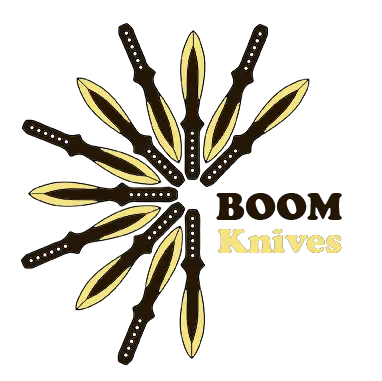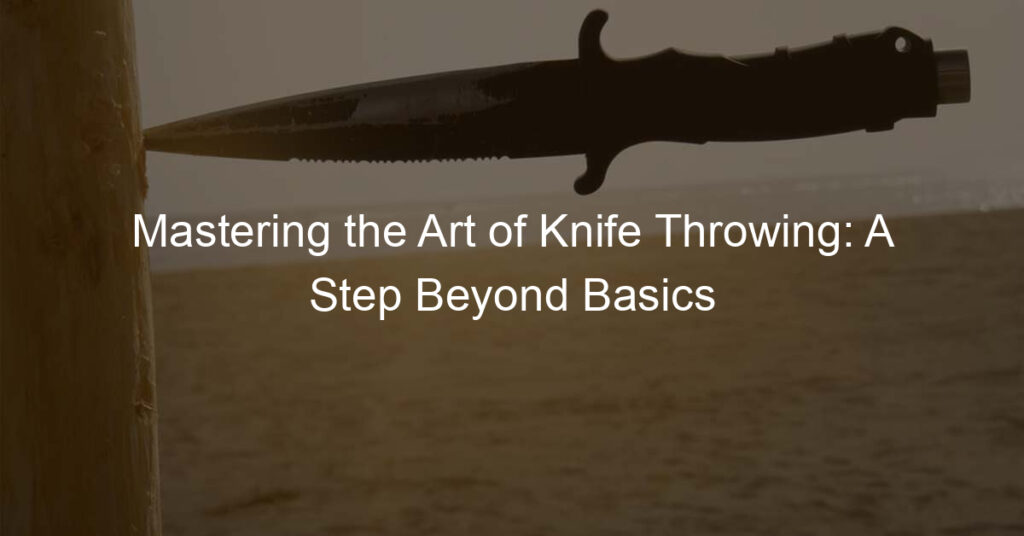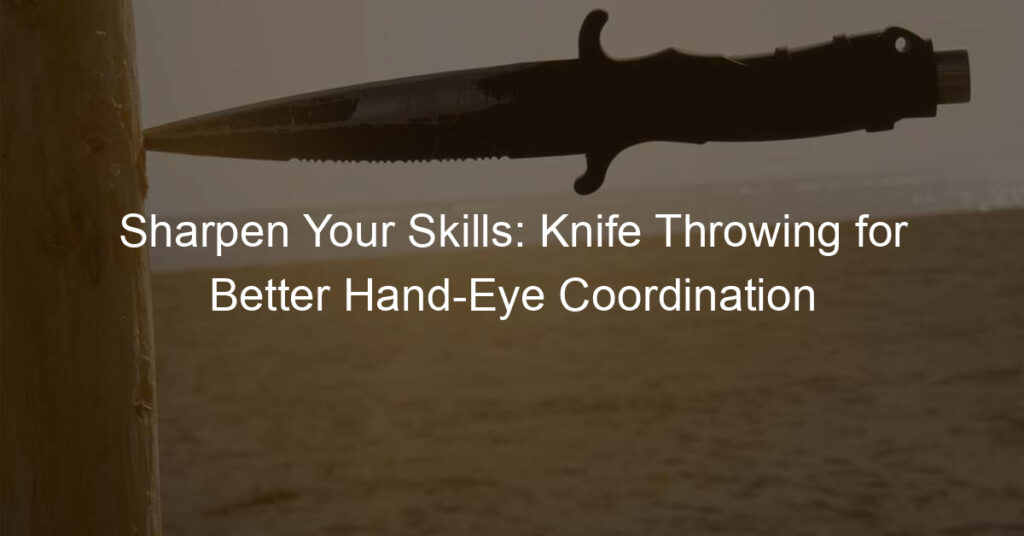Introduction to Advanced Knife Throwing Techniques
Whether you’re a seasoned thrower looking to up your game, or a beginner ready to take the next step, this guide is for you. Let’s dive in!
-
- Understanding the Basics
Knife throwing is a skill that requires precision, control, and a deep understanding of your equipment. The basic knife throwing techniques revolve around grip, stance, and throwing motion. Mastering these elements is the first step towards becoming an advanced knife thrower.
The most common methods are the hammer grip and the pinch grip. The stance involves positioning your body correctly, with your dominant foot forward. The throwing motion should be smooth and controlled, with the arm moving in a straight line towards the target.
-
- Transitioning from Basic to Advanced Techniques
This involves learning new grips, throws, and tricks, as well as understanding how to adjust your throw based on distance and target size.
Advanced techniques include the no-spin throw, the underhand throw, and the backhand throw. Each of these techniques requires a different grip and throwing motion, and they can be used to hit targets at various distances and angles.
Transitioning to advanced techniques also involves learning how to throw multiple knives at once, and how to throw larger, heavier knives. These skills can add a new level of challenge and excitement to your knife throwing practice.
Professional Knife Throwing: A Deeper Dive
Essential Knife Throwing Skills
- Accuracy: The first and most important skill in knife throwing is accuracy. This is the ability to hit your target precisely where you aim. Accuracy is achieved through a combination of proper technique, focus, and lots of practice. According to a Wikipedia article on knife throwing, the best throwers can consistently hit a target the size of a coin from several meters away.
- Speed: Speed is another crucial skill in knife throwing. The faster you can throw your knife, the less time your opponent has to react. Speed is not just about physical strength, but also about technique and timing. A well-timed throw can be just as fast as a powerful one.
- Consistency: The third essential skill is consistency. This means being able to throw your knife with the same accuracy and speed, throw after throw. Consistency is achieved through regular practice and a deep understanding of your own throwing technique.
Knife Throwing Training
-
- Importance of Regular Practice
It’s not just about throwing a knife; it’s about throwing it accurately and consistently. The more you practice, the better you become. According to a Wikipedia article, it takes approximately 10,000 hours of practice to achieve mastery in a field. So, make sure you dedicate enough time to practice regularly.
-
- Training Drills and Exercises
-
-
- Target Practice: Start by throwing at a large target and gradually reduce its size as your accuracy improves.
- Speed Drills: Set a timer and see how many accurate throws you can make within a certain time frame. This will help improve your speed.
- Consistency Drills: Try to hit the same spot repeatedly. This will help you develop consistency.
-
Knife Throwing Safety: A Must-Know
-
- Safe handling of knives
Always hold the knife by the handle and never by the blade. Make sure your hands are dry to prevent the knife from slipping. When passing a knife to someone else, offer the handle first. A knife is not a toy and should be treated with respect. For more information on safe knife handling, visit this Wikipedia page on Knife Safety.
Make sure there are no people, pets, or valuable items in your throwing range. Always throw at a designated target and never aim at living things. Wear protective gear, such as gloves and eye protection, to prevent injuries. It’s also important to regularly inspect your equipment for any damage.
-
- First aid tips
If a cut occurs, clean the wound with warm water and soap, apply an antibiotic ointment, and cover it with a clean bandage. Seek immediate medical attention for deep wounds. For more detailed first aid tips, check out this Wikipedia page on First Aid.
Essential Knife Throwing Equipment
Choosing the Right Knife
-
- Weight and Balance
A knife that is too light may not stick to the target properly, while a knife that is too heavy may be difficult to throw accurately. The balance of the knife is also important. A well-balanced knife will rotate predictably, making it easier to hit the target. According to a Wikipedia article on knife throwing, the ideal weight for a throwing knife is between 200 to 300 grams.
-
- Blade and Handle Design
A knife with a sharp point is more likely to stick to the target. The handle should be comfortable to hold and not too slippery. Some throwers prefer knives with a handle that is slightly heavier than the blade, as this can help to stabilize the knife during flight. However, the choice of blade and handle design often comes down to personal preference.
Other Essential Equipment for Knife Throwing
-
- Target Boards
This is where you’ll be aiming and throwing your knives. It’s important to choose a target board that’s made of soft wood, as it allows the knife to stick easily. The size of the target board can vary, but a standard one is usually around 16 inches in diameter. You can purchase these boards from sports stores or online. Alternatively, you can also make your own if you’re handy with tools. Just make sure it’s sturdy and safe to use.
-
- Safety Gear
That’s why it’s essential to invest in safety gear. This includes a pair of sturdy gloves to protect your hands, safety goggles to shield your eyes from any flying debris, and a first aid kit for any minor injuries. Safety should always be your top priority when engaging in this sport.
Participating in Knife Throwing Competitions
Preparing for Competitions
- Training regimen: It involves practicing your throws, improving your aim, and increasing your strength and endurance. A good training regimen should be consistent and progressive. Start with basic throws and gradually move on to more complex techniques. According to a Wikipedia article, professional knife throwers often train for several hours a day to hone their skills.
- Mental preparation: It requires concentration, focus, and the ability to remain calm under pressure. Mental preparation might involve techniques like visualization, where you imagine yourself successfully making each throw. It could also involve mindfulness exercises to help you stay focused and present during the competition. A study found that athletes who engage in mental preparation techniques often perform better in competitions.
Understanding Competition Rules
-
- Scoring System
The scoring system in knife throwing competitions can vary, but it generally involves points awarded based on the accuracy of the throw. The closer your knife lands to the center of the target, the higher your score. For example, a throw that hits the bullseye might earn you 5 points, while a throw that lands in the outer ring might only earn you 1 point. It’s important to understand the specific scoring system of the competition you’re entering, as this can greatly affect your strategy.
-
- Equipment Regulations
These rules dictate what type of knives you can use, as well as other equipment like targets and protective gear. For instance, some competitions might require knives of a certain length or weight, while others might allow competitors to use their own knives. Always check the competition’s equipment regulations before you participate to ensure your gear is up to standard.
Mastering Knife Throwing Tricks
- Popular Knife Throwing Tricks
-
- The Spin Throw: This is the most common trick. The thrower spins the knife once before it hits the target. It requires a good understanding of distance and rotation.
- The No-Spin Throw: This trick involves throwing the knife in such a way that it does not spin in the air. It’s a bit more challenging but very impressive when done correctly.
- The Half Spin Throw: This trick is similar to the spin throw, but the knife only spins half a rotation before hitting the target. It’s a great trick for short distances.
-
- Tips for Executing Tricks Successfully
- Practice Regularly: The more you practice, the better you’ll get. Start with a basic throw and gradually move on to more complex tricks.
- Focus on Your Grip: Your grip on the knife is crucial. It should be firm but not too tight. The knife should be an extension of your hand.
- Understand Distance and Rotation: The distance from the target and the rotation of the knife are key factors in successful knife throwing. Experiment with different distances and rotations to find what works best for you.
- Stay Safe: Follow safety guidelines when practicing knife throwing. Never throw a knife towards a person or an animal, and always make sure your target area is clear.
Conclusion: Your Knife Throwing Guide
- Recap of Advanced Techniques
We’ve delved into the world of advanced knife throwing techniques, exploring the intricacies of grip, stance, and release. We’ve learned about the importance of consistency, precision, and focus. We’ve also discovered the art of mastering various tricks, from the basic rotational throw to the more complex no-spin technique.
As the old saying goes, “practice makes perfect”. The more you practice, the more you’ll improve your accuracy and consistency. Don’t be discouraged if you don’t get it right the first time. Keep trying, and you’ll eventually master these techniques.
- Next Steps in Your Knife Throwing Journey
Now that you’ve gained a solid understanding of knife throwing, what’s next? There are several paths you can take.
Firstly, you might consider participating in knife throwing competitions. This can be a great way to test your skills, meet fellow enthusiasts, and learn from the best in the field. You can find more information on knife throwing competitions on Wikipedia.
Secondly, you could invest in higher quality equipment. As your skills improve, you might find that your current equipment is no longer sufficient. Upgrading your knives and targets can make a big difference in your performance.
Finally, consider sharing your passion with others. Teach your friends, start a local club, or even start a blog or YouTube channel. Sharing your knowledge and experiences can be incredibly rewarding and can help grow the knife throwing community.







